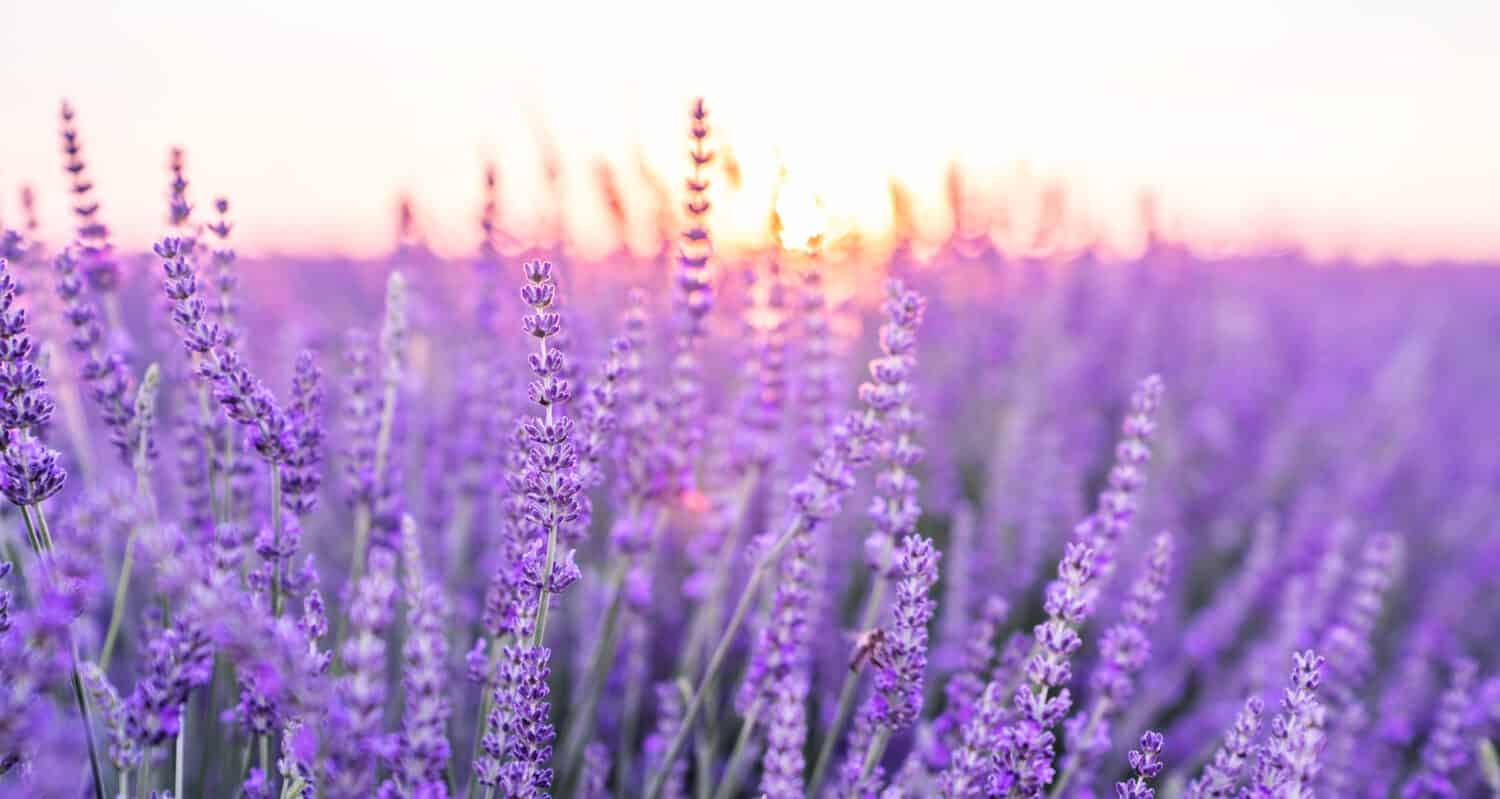Do you adore lavender and want to plant some around your home or garden? Are you feeling overwhelmed trying to choose from among the 45 species and 450 varieties? If so, that is completely understandable. With so many stunning members of the Lamiaceae (mint) family, making a choice can be difficult. But we are here to help. Below, we will take a look at 32 types of lavender. After learning more about them, we hope you can settle on one (or more) to incorporate into your landscape.
1. English Lavender
English lavender (Lavandula angustifolia) is one of the most popular varieties. It has that highly sought-after, traditional lavender scent. Most culinary lavender falls into this native of Spain, Italy, and southern France.
It is cold hardy, so it does well in USDA Hardiness Zones 5-9. It is characterized by its short spikes of flowers that vary in color depending on the cultivar. Blossoms range from different blues to white and bloom around June or July for roughly a month. This type prefers poor, sandy soil and good drainage.
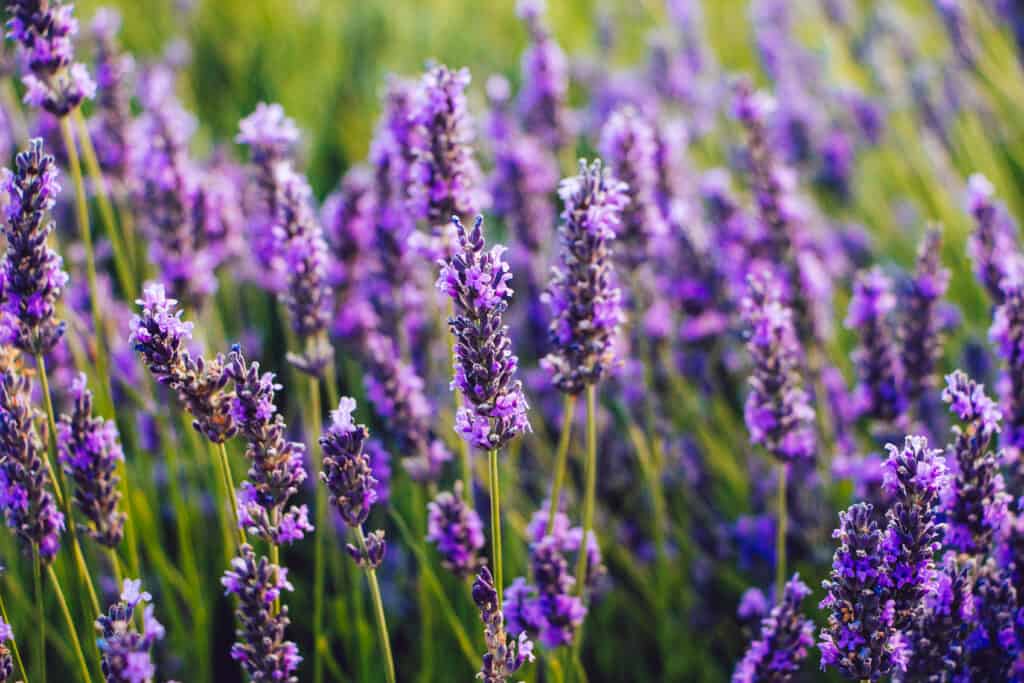
English lavender is one of the most popular types since it is ideal for culinary purposes.
©iStock.com/ASIFE
2. ‘Hidcote’ Lavender
Lavandula angustifolia ‘Hidcote’ has dark flowers, a strong scent, and long-lasting blooms. Since this plant grows up to 1 to 2 feet wide, it makes a fantastic addition to hedges. Hidcote blooms one time in late spring, so make sure to harvest its flowers while you can!
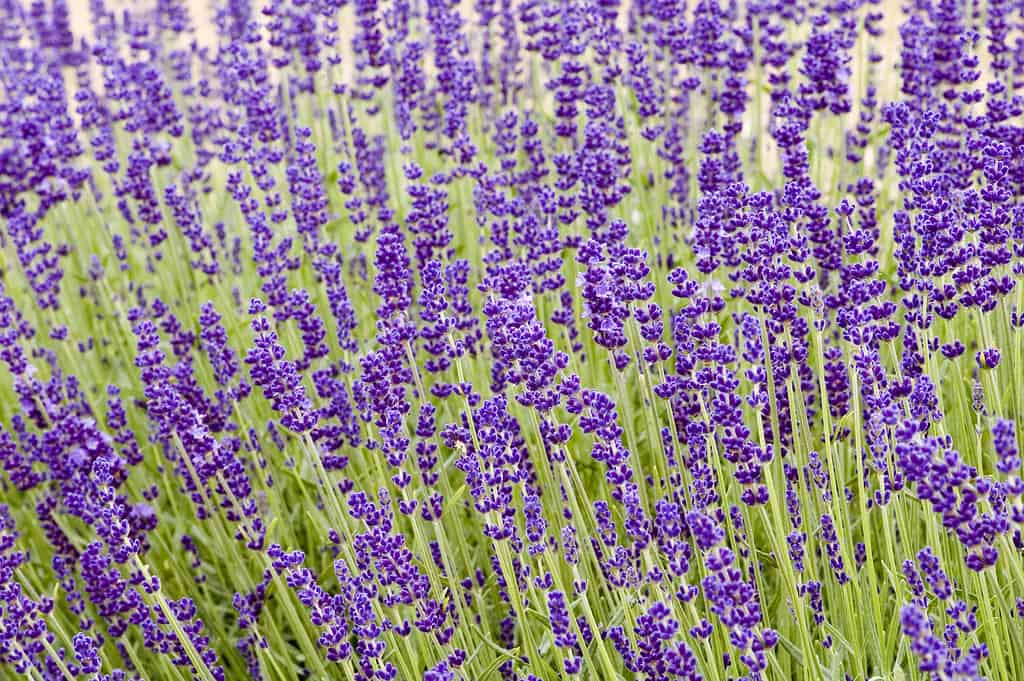
‘Hidcote’ lavender only blooms once every year.
©gardendata/ via Getty Images
3. ‘Alba Nana’ Lavender
Otherwise known as “Dwarf dawn,” Lavandula angustifolia ‘Alba Nana’ has stunning white blooms and a delightful fragrance. It only reaches 10-12 inches tall and 1 to 2 feet wide, making it great for containers or rock gardens. This cultivar blooms once in mid to late summer.
4. ‘Munstead’ Lavender
Lavandula angustifolia ‘Munstead’ was reportedly grown by royalty due to its compact shape and lovely fragrance. This cultivar grows approximately 1 to 2 feet tall and 2 to 3 feet wide. It is ideal for rock gardens, hedges, and herb gardens. ‘Munstead’ blooms once in late spring to mid-summer.
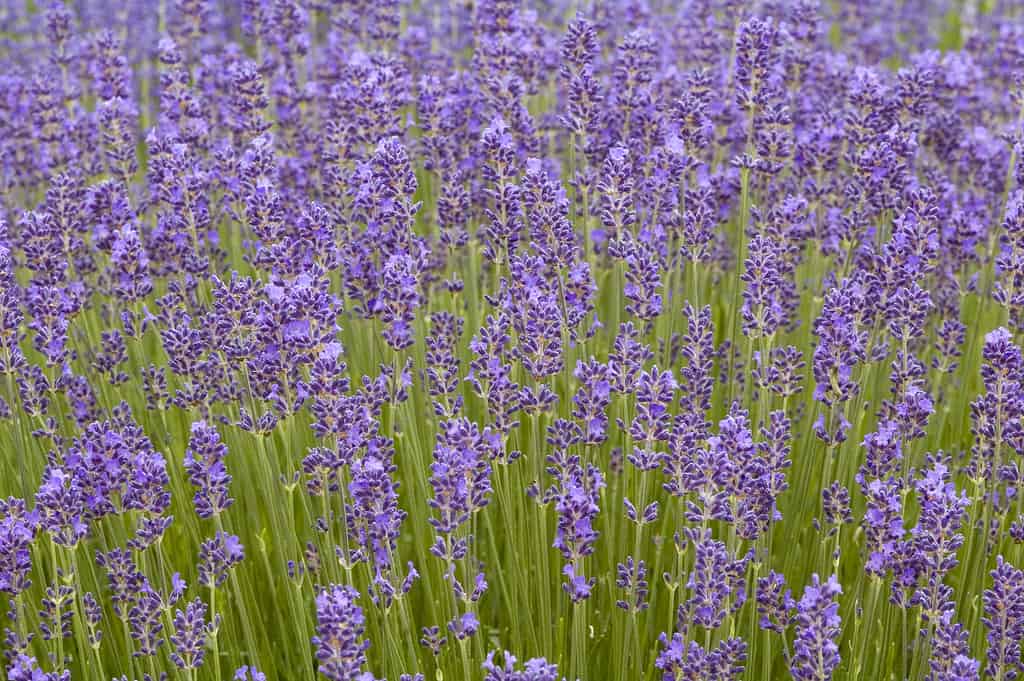
Lavandula angustifolia Munstead is one of the true hardy Lavenders with lilac blue foliage.
©gardendata/ via Getty Images
5. ‘Celestial Star’ Lavender
Native to New Zealand, Lavandula angustifolia ‘Munstead’ is a beauty. It has white flowers gracing the top of a roughly 30-inch tall shrub. This cultivar is exceptionally cold hardy, making it the ideal addition to a Zone 5 garden.
6. ‘Blue Cushion’ Lavender
Lavandula angustifolia ‘Blue Cushion’ is a compact, low-growing plant that only reaches 1.5 feet in each direction. This small shape makes it perfect for countless spaces, including borders and containers. Additionally, since it is a repeat bloomer, it is loved by pollinators.
7. ‘Thumbelina Leigh’ Lavender
This cultivar has shorter and fewer flowers on longer stems. Lavandula angustifolia ‘Thumbelina Leigh’ is great for borders or hedges since it only gets roughly 10 to 12 inches tall and wide. And the best part is that it blooms starting in late spring and may bloom multiple times.
8. Spanish Lavender
Spanish lavender (Lavandula stoechas) is known for its strong aroma that makes delightful lavender oil. Historically, it also played a prominent role in medicinal applications like four thieves vinegar.
This species is native to the Mediterranean region and typically gets grown as an ornamental plant. It thrives in hot, dry climates like USDA Hardiness Zones 8-9 but can handle some humidity. In general, it is the tallest type, reaching up to 3 feet. And it is beloved by pollinators.
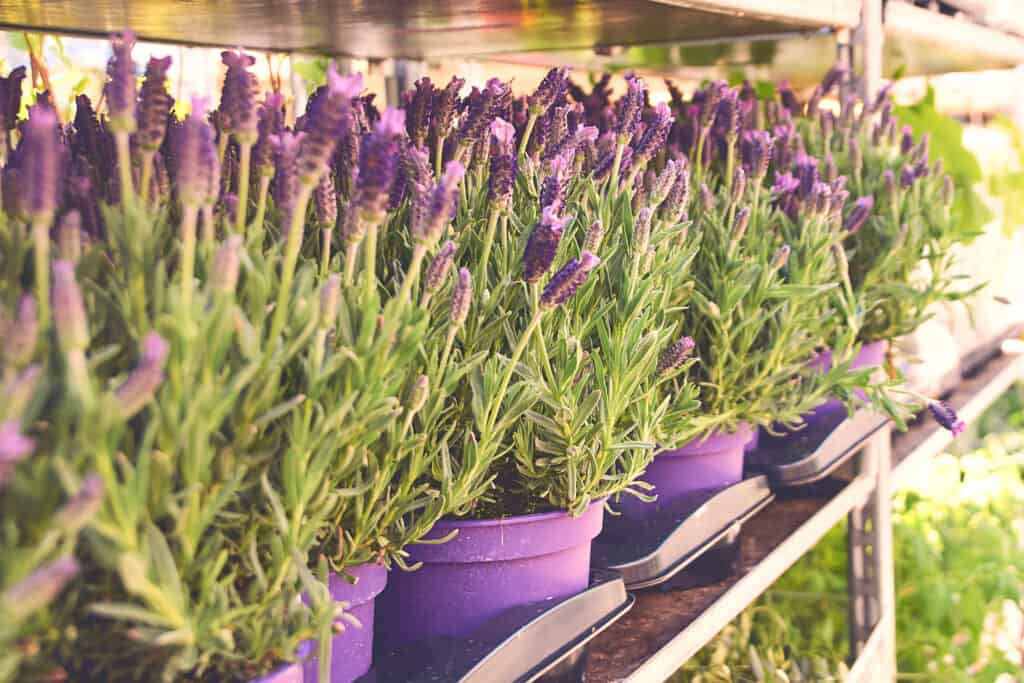
Spanish lavender grows to be one of the tallest lavender plants once it reaches maturity.
©iStock.com/Berezko
9. ‘Otto Quast’ Lavender
Consider planting Lavandula stoechas ‘Otto Quast’ lavender in your rock gardens or along your border areas. It has purple flowers and gray-green foliage. Additionally, this drought-tolerant cultivar grows well in USDA Hardiness Zones 7-9.
10. ‘Ballerina’ Lavender
Lavandula stoechas ‘Ballerina’ has cone-shaped flowers that are dark purple-blue with white bracts. The foliage looks similar to rosemary before the blooms arrive. It thrives in poor soils and can grow to roughly 2 feet tall.
11. ‘Blueberry Ruffles’ Lavender
As its name suggests, Lavandula stoechas ‘Blueberry Ruffles’ has ruffled violet petals. While it reaches up to 2 feet tall and wide, it is still ideal for containers and rock gardens. This cultivar can tolerate humidity and droughts. It grows well in USDA Hardiness Zones 8-10.
12. ‘Van Gogh’ Lavender
This lovely cultivar has white petals with pale violet or blue flowers. Lavandula stoechas ‘Van Gogh’ grows up to 30” tall and wide. Lavender lovers and pollinators will be thrilled to discover that it blooms throughout the season.
13. ‘Anouk’ Lavender
Lavandula stoechas ‘Anouk’ have aromatic, plum-colored flowers that bloom continuously throughout the growing season. These compact plants need poor or rocky soil. They will bring the butterflies in droves, thanks to their unique flower head.
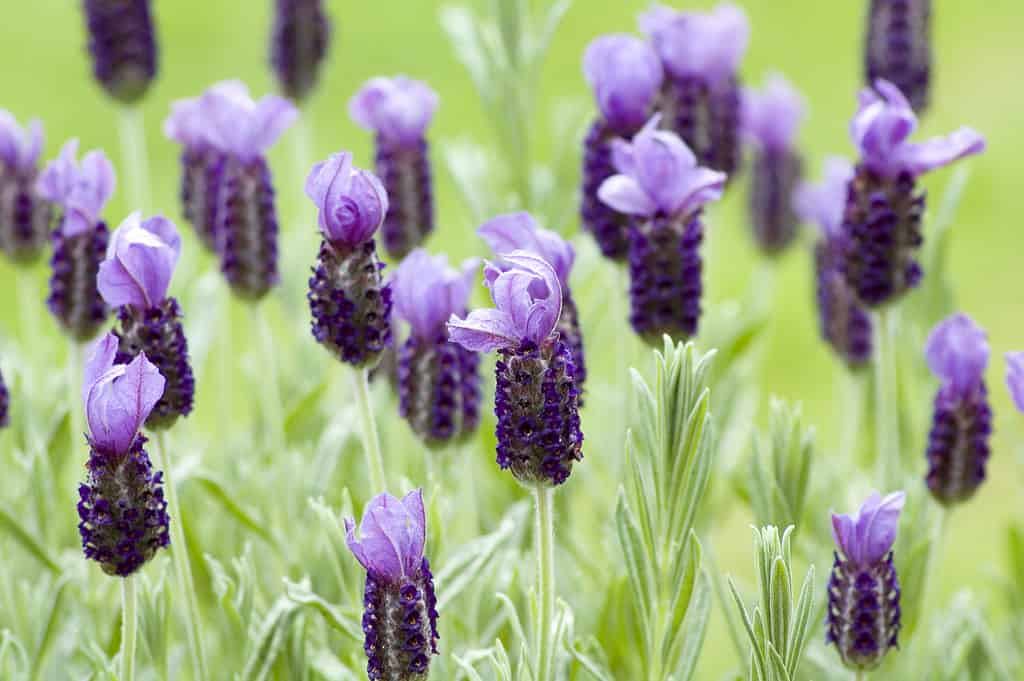
The aromatic ‘Anouk’ lavender flowers attract butterflies.
©gardendata/ via Getty Images
14. ‘Fathead’ Lavender
This compact cultivar is great for containers and loves sandy or rocky soil. Lavandula stoechas ‘Fathead’ has lovely purple-black flowers and a mild but delightful fragrance.
15. French Lavender
This ornamental lavender has a lighter scent and a unique leaf structure. It has petal-topped flowers that bloom longer, from early summer through fall. French lavender (Lavandula dentata) is native to Spain and North Africa. So it likes warmer climates, like USDA Hardiness Zones 8-9.
It is low-maintenance, holds up to dead-heading, and is great for arrangements. However, the beautiful light lavender blue flowers are not for culinary use.
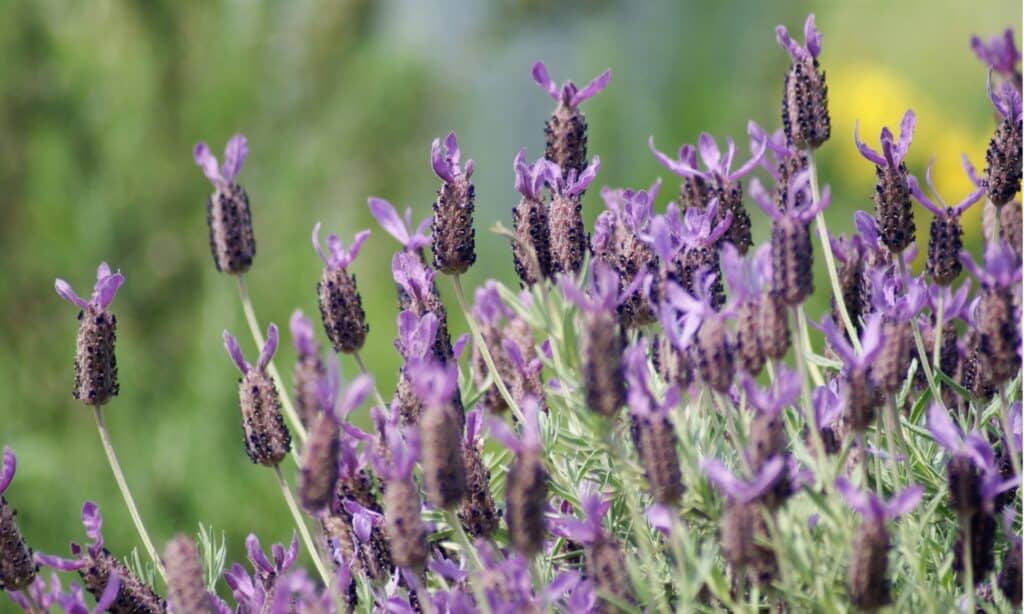
French lavender has shrublike growth and a milder fragrance.
©iStock.com/htmSana
16. ‘Pretty Polly’ Lavender
Lavandula dentata ‘Pretty Polly’ has dark purple flowers with a yellow center. These blossoms are aromatic and arrive three times a season. This cultivar grows best in USDA Hardiness Zones 8-9 and reaches 1 to 2 feet tall and wide.
17. ‘Regal Splendour’ Lavender
The dark green foliage and dark purple flowers of Lavandula dentata ‘Regal Splendour’ are a sight to behold. The lengthy stalks reach about 2 feet tall. This cultivar grows best in USDA Hardiness Zones 7-9.
18. ‘Goodwin Creek Grey’ Lavender
With slightly silver leaves and dark purple flowers, the Lavandula dentata ‘Goodwin Creek Grey’ makes a serious impression. This low-maintenance plant only hits two feet tall and wide at maturity, making it ideal for containers.
19. ‘Allwood’ Lavender
With a compact growing habit, soft foliage, and a long bloom time, Lavandula dentata ‘Allwood’ makes a fantastic addition to any garden. It has pale purple that people and pollinators love.

Pollinators love ‘Allwood’ lavender.
©Neilstha Firman/ via Getty Images
20. ‘Lambikins’ Lavender
Lavandula dentata ‘Lambikins’ grows up to roughly 2 feet tall and is ideally suited for USDA Hardiness Zones 8-11. It has highly fragrant, light purple blossoms.
21. ‘Ploughman’s Blue’ Lavender
The gray foliage and dark purple flowers make Lavandula dentata ‘Ploughman’s Blue’ a stunning addition to any garden or landscape. It is also perfect for container gardening or to add to hedge space.
22. Portuguese Lavender
Portuguese lavender (Lavandula latifolia) grows wild in the Mediterranean and lower altitude sections of Europe, so it loves hot climates. This variety gets grown commercially for oils.
Its flowers bloom later in the summer than some of the other types of lavender. And it is not commonly planted in gardens, though there is no reason you can’t!
23. Egyptian Lavender
Egyptian lavender (Lavandula multifida) has pale purple flowers that bloom in the spring and summer. This plant grows up to 3 feet tall and has a pungent aroma. If you think you can tolerate the scent, consider adding it to your zone 6-8 garden.
24. Lavandin Lavender
This type of lavender is a hybrid of English and Portuguese varieties. So it gets the best of both worlds and is tolerant of heat and cold hardy. The Lavandin (Lavandula x intermedia) plants are sterile. They grow best in USDA Hardiness Zones 5-9. Be prepared for a fantastic but strong aroma.
25. ‘Alba White Grosso’ Lavender
Lavandula x intermedia ‘Alba White Grosso’ flowers are a gorgeous white. This cultivar produces bushy, tall plants that reach 2 to 3 feet tall. The flowers are wonderful additions to dry bouquets.
26. ‘Sensational’ Lavender
These easy-to-grow plants are drought-resistant and provide one to two flushes of flowers annually. The Lavandula x intermedia ‘Sensational’ blossoms are large and dark blue. This plant has silver-ish foliage and reaches 2 feet wide and 1.5 feet tall at maturity.
27. ‘Hidcote Giant’ Lavender
The flowers of Lavandula x intermedia ‘Hidcote Giant’ grow up to 4 inches long. They have a strong aroma and are excellent for cut flower arrangements. This cultivar grows up to 2 to 3 feet tall and 3 to 4 feet wide.
28. ‘Phenomenal’ Lavender
Lavandula x intermedia ‘Phenomenal’ is cold-hardy, drought tolerant, and can handle humility. The low-maintenance plant has traditional lavender loved by pollinators.
29. ‘Fred Boutin’ Lavender
This stunning cultivar grows up to 2 feet high and 3 feet wide in USDA Hardiness Zones 6 to 9. Lavandula x intermedia ‘Fred Boutin’ blooms from July to September. It grows best in sandy soil, and its flowers are great for potpourris.
30. ‘Dutch’ Lavender
Lavandula x intermedia ‘Dutch’ is hardy and shrub-like. It loves rocky soil and hits 2 feet tall at maturity. This cultivar has a great lavender scent, making it ideal for oils.
31. ‘Super’ Lavender
Make plenty of room for Lavandula x intermedia ‘Super.’ It grows to 3 feet tall and wide! The large violet flowers have a fantastic fragrance for essential oil. It is a low-maintenance plant and good for beginners.
32. ‘Crystal Lights’ Lavender
Lavandula x intermedia ‘Crystal Lights’ has white flowers that make an appearance multiple times every season. Since they are smaller (reaching roughly 15 inches tall and wide), they are great for container gardening.
Summary of the 32 Most Important Types of Lavender
| Number | Name | USDA Hardiness Zone |
|---|---|---|
| 1 | English Lavender | 5-9 |
| 2 | ‘Hidcote’ | 5-9 |
| 3 | ‘Alba Nana’ | 5-9 |
| 4 | ‘Munstead’ | 5-9 |
| 5 | ‘Celestial Star’ | 5-9 |
| 6 | ‘Blue Cushion’ | 5-9 |
| 7 | ‘Thumbelina Leigh’ | 5-9 |
| 8 | Spanish Lavender | 8-9 |
| 9 | ‘Otto Quast’ | 7-9 |
| 10 | ‘Ballerina’ | 8-9 |
| 11 | ‘Blueberry Ruffles’ | 8-10 |
| 12 | ‘Van Gogh’ | 8-9 |
| 13 | ‘Anouk’ | 8-9 |
| 14 | ‘Fathead’ | 8-9 |
| 15 | French Lavender | 8-9 |
| 16 | ‘Pretty Polly’ | 8-9 |
| 17 | ‘Regal Splendour’ | 7-9 |
| 18 | ‘Goodwin Creek Grey’ | 8-9 |
| 19 | ‘Allwood’ | 8-9 |
| 20 | ‘Lambikins’ | 8-11 |
| 21 | ‘Ploughman’s Blue’ | 8-9 |
| 22 | Portuguese Lavender | 6-8 |
| 23 | Egyptian Lavender | 6-8 |
| 24 | Lavandin | 5-9 |
| 25 | ‘Alba White Grosso’ | 5-9 |
| 26 | ‘Sensational’ | 5-9 |
| 27 | ‘Hidcote Giant’ | 5-9 |
| 28 | ‘Phenomenal’ | 5-9 |
| 29 | ‘Fred Boutin’ | 6-9 |
| 30 | ‘Dutch’ | 5-9 |
| 31 | ‘Super’ | 5-9 |
| 32 | ‘Crystal Lights’ | 5-9 |
Thank you for reading! Have some feedback for us? Contact the AZ Animals editorial team.

